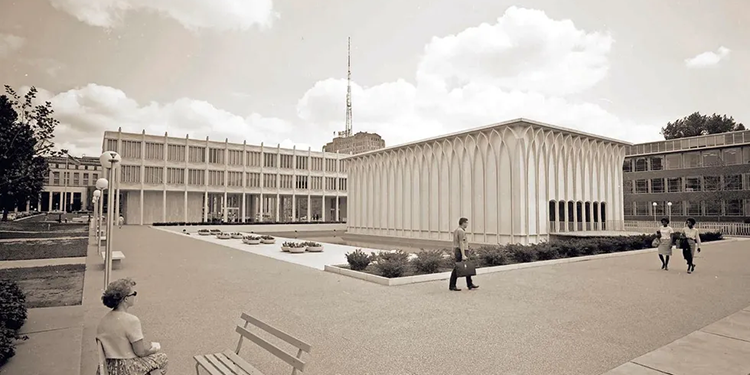
February 21, 2023
Meet the 2023 Christopher Kelley Leadership Development Cohort
AIA Detroit is pleased to introduce our 2023 Christopher Kelley Leadership Development Scholars!
GET TO KNOW THIS YEAR’S COHORT: (more…)

AIA Detroit is pleased to introduce our 2023 Christopher Kelley Leadership Development Scholars!
GET TO KNOW THIS YEAR’S COHORT: (more…)

WHAT ARE WE OFFERING?
Two scholarships: (1) $1,500 and (1) $3,000. The 2023 scholarships are a joint program between AIA Detroit and AIA National, who awarded our component $1,000 in funding!
PURPOSE:
The scholarships are created to support and foster a diverse profession that is representative of our greater chapter community. AIA Detroit is committed to supporting the next generation of licensed architects and recognizes that diversity in the profession starts by diversifying the pipeline to the profession and supporting individuals along the long path toward becoming licensed architects.
The AIA Detroit Scholarships is being established to recognize deserving architecture students who will be attending a NAAB-accredited institution within our chapter boundary (University of Detroit Mercy and Lawrence Technological University) or whose permanent residence is in the AIA Detroit chapter boundary (Macomb, Oakland, St. Clair, and Wayne counties) and is enrolled in a NAAB-accredited institution elsewhere.
Scholarship funds can be applied towards tuition, books, and other educational-related fees.
The scholarships intend to support future BIPOC, LGBTQIA+, and/or women architects as we aim to have our profession better reflect our diverse chapter community.
WHO IS ELIGIBLE?
To be considered for selection, the following criteria must be met:
1. The applicant must be a Junior, Senior, or graduate candidate with at least one year left to complete their architectural degree.
2. The applicant must be a student enrolled in an architectural program at the University of Detroit Mercy or Lawrence Technological University OR A student whose permanent residence is in the AIA Detroit chapter boundary (Macomb, Oakland,
St. Clair or Wayne counties) who is enrolled in a NAAB-accredited architectural program outside of the AIA Detroit chapter boundary.
3. The applicant should identify as BIPOC, LGBTQIA+, and/or be a woman as we aim to foster a diverse profession that represents our greater chapter community.
4. The applicant should demonstrate enthusiasm and participation in areas of the built environment. Participation in school activities and/or leadership roles in other organizations may be considered.
APPLICATION PROCEDURE:
1. Applications must be received no later than April 14, 2023, by 5:00 pm EST.
2. Complete the biographical data section of the application.
3. Forward official transcript(s) from all colleges/universities attended to be used for verification of year- not grades. Forward to: scholarship@aiadetroit.com
4. Submit (1) academic/faculty/personal letter of reference of your choice.
5. Write a 200-500-word essay to explain why you want to be an architect and should be a recipient of one of these scholarships.
6. Submit the application, forwarded, transcript, essay, and reference to: scholarship@aiadetroit.com
7. The winning recipients will be contacted and there will be an announcement posted on the AIA Detroit Chapter website.
8. Questions regarding the application procedure may be directed to: scholarship@aiadetroit.com
Please fill out the AIA Detroit Scholarships Biographical Data Sheet here: 2023_AIADetroit_Scholarships.
Please forward to scholarship@aiadetroit.com:
• Biographical Data Sheet.
• Transcript – Forward official transcript(s) from all colleges/universities attended to be used for verification of year- not grades.
• Reference – One academic/faculty/personal letter of reference of your choice.
• Essay – Write a 200-500 word essay to explain why you want to be an architect and should be a recipient of one of these scholarships.
QUESTIONS: Questions regarding the application procedure may be directed to: scholarship@aiadetroit.com

Louis Aguilar | The Detroit News
Detroit — After more than three decades of sitting empty, Wayne State University will restore a reflecting pool on campus designed by famed architect Minoru Yamasaki, who later created the original World Trade Center in New York City. The shallow pool surrounding the Helen L. DeRoy Auditorium will be repaired and refilled with water as part of a $2 million restoration of the modernist-style building in Detroit. If things go as planned, the pool will be operational by the time Wayne State President M. Roy Wilson retires on July 31. Wilson is among many who advocated to restore the major design element of the building.
“It’s a masterpiece. It’s a little tarnished, but we are bringing it back,” said architect Ashley Flintoff, Wayne State’s director of planning and space management.
Yamasaki created four buildings at Wayne State, including one that helped the Detroit-based architect achieve international acclaim: the McGregor Memorial Conference Center. The McGregor also has a reflecting pool. Like the DeRoy, McGregor’s reflecting pool was drained and lay dormant for years because of leakage issues. McGregor’s pool was restored in 2013 after a $1.8 million campaign after being empty for about 15 years.
That means for the first time in decades, both Yamasaki’s reflecting pools on the WSU campus could be working this summer.
The reflecting pools are only filled during warm months and drained during the cold months.
First-year student Jeni Dylans said she wondered why the DeRoy reflecting pool was empty.
“If someone that talented had a vision they created for all of us to enjoy, then we should definitely respect that,” Dylans said as she walked by the space this past week. “I love the McGregor pool, it gives a relaxing vibe that I appreciate.”

Cassidy Johncox, Senior News Editor | ClickOnDetroit
Water garden a main feature at Detroit’s Ralph C. Wilson, Jr. Centennial Park
DETROIT – A 2.5-acre water garden is coming to the new Ralph C. Wilson, Jr. Centennial Park located along Detroit’s West Riverfront.
The 22-acre park is currently under construction and set to open on the West Riverfront in 2024. Just near Corktown, the park is expected to feature four main attractions — including the water garden, which was just named the Huron-Clinton Metroparks Water Garden, officials said Monday, Jan. 10. It will be the first Metroparks location in Detroit.
In addition to regular visitors, the water garden will also provide educational opportunities and programming for students, officials said Monday. The garden will reportedly feature winding walking paths, tranquil seating areas, educational signage and open-air classrooms.
The Metroparks are working to increase access to their services in Detroit and all throughout Wayne County as part of their new strategic plan.
“The naming of the Water Garden is incredibly exciting for us,” said Amy McMillan, director of Huron-Clinton Metroparks. “The Metroparks form a greenbelt of vibrant active and natural spaces around the Metro Detroit region, but for decades there has been a gap in Metroparks presence within the city of Detroit. We are finally making progress towards closing that gap and establishing a physical presence that residents can engage with daily. We know we still have a lot of work to do, but we are grateful for this strong partnership that is helping us realize progress towards that goal.”
The other major attractions at the Ralph C. Wilson, Jr. Centennial Park include the William Davidson Sport House, the Delta Dental Play Garden and the DTE Foundation lawn. Construction broke ground in May 2022, though the conservancy has been working toward the redevelop of the West Riverfront for years.
The park is part of the conservancy’s plan to develop 5.5 miles of revitalized riverfront in an effort to “dramatically change the landscape along the downtown riverfront,” and likely “significantly boost economic benefit in the area as well.”
Learn more about the project on the conservancy’s website here.
Read the original article here.

Patra Wroten | AIA
2023 marks the start of a historic first for AIA – an all-female leadership team. AIA’s CEO/EVP Lakisha Ann Woods, CAE, AIA President Emily Grandstaff-Rice, FAIA, and 2024 President-elect Kimberly Nicole Dowdell, AIA, look to the future of the organization and the profession as they lead AIA’s commitment to building a more equitable and diverse profession and a more sustainable built environment.
How do you want to use your role to transform the profession:
Lakisha Ann Woods: I was drawn to AIA because of its strategic plan. I am inspired by the leadership team and their dedication to AIA’s goal. I want to use my role to develop clear and measurable steps firms can take to increase the diversity of their leadership teams. I want our team to share stories of success from other firms who have seen growth and innovation because of their focus on diversifying their leadership teams. We know that data shows that when companies focus on diversifying their leadership teams, they become more profitable and innovative.
Emily Grandstaff-Rice: My service in this role expands the conversation about how leadership comes through different voices and at different stages in one’s career. I am not what you expect an AIA President to look or sound like, due to my gender and age. I have been a strong advocate for equity and climate action in the profession. I will use my role to continue those efforts, as well as elevate the Framework for Design Excellence. I also want to focus on how the economic issues we face in the profession will position us well for the future.
Kimberly Nicole Dowdell: I am excited about working with AIA’s leadership to raise the public profile of the architect and help AIA members prosper. Our role as leaders is to secure the future, and I am interested in leveraging my position with AIA to bolster the recruitment and retention of the very best design talent. Architects have a bright future ahead if we become more intentional now about advocating for our value in the marketplace, creating more pathways for diverse talent to thrive in our profession, and ensuring that all architects are prepared to design for a more healthy and sustainable tomorrow.
What inspires you to lead?
Emily Grandstaff-Rice: The members and the impact they have on the built environment. Earlier in my career, I didn’t always see myself reflected in the leadership, so in some way I am creating the change that I wanted to see.
Kimberly Nicole Dowdell: I am inspired by the tremendous potential within the profession of architecture, both for people who focus on the design of buildings and those of us who design solutions beyond buildings. I look forward to helping AIA empower all architects to thrive and improve the health of their communities.
Lakisha Ann Woods: I am inspired by the people that we represent and the importance of the work that they do in their communities. Architects are uniquely positioned to transform the built environment and positively impact our well-being. I am also excited for the opportunity to lead the talented team at AIA. The staff has provided wonderful feedback that has shaped much of the direction I have taken as we adjust the organization to better serve the architecture community.
What are you proudest of so far in your leadership at AIA?
Lakisha Ann Woods: I was very proud to secure the feature for AIA and myself as a judge on “America ByDesign,” an architecture show featured on CBS. Throughout this past year, members have said how important it is for AIA to build excitement about architecture in the public. This feature showcased all AIA members and AIA member projects in a six-episode series. It is streaming on CBS platforms now and in February will be in six major markets.
What does AIA leadership mean to you?
Emily Grandstaff-Rice: The experience is like no other! AIA leadership is a trust to have critical conversations, ask the right questions, and celebrate the amazing work of our members. I still have 20 or more years in the profession, and I am so honored to serve at this time and look forward to use what I learn to grow future leadership.
Kimberly Nicole Dowdell: It means having an opportunity to not only have a voice in rooms where important decisions are being made about the profession, but also to give voice to members who have historically felt unheard.
How do you want to be a catalyst for Equity within AIA and the industry?
Lakisha Ann Woods: It’s all about storytelling. It’s about showcasing and celebrating the amazing design work of architects, particularly of women and people of color, in this country. We have to do more to shine the spotlight out there, and we’re going to do just that.
Emily Grandstaff-Rice: As architects, we need to acknowledge we don’t have all the answers, but we know how to ask the right questions. There is a subtlety to that humility. For every project, for every effort we need to ask if we are not just improving our communities, but what we are missing? When we are guided by the people we serve, we both learn from and create the most appropriate solutions.
Kimberly Nicole Dowdell: By serving as an example of what is possible. My campaign slogan was, “Envision New Possibilities,” which still applies as I step into this position as the first Black woman and the first millennial to serve as national president. My hope is that not only my presence but also my strong performance in the role, will inspire the next generation to get engaged with making a difference in our profession. Representation matters and is a key building block of equity within AIA and beyond.
Read the original article here.

Metropolis Editors | Metropolis
This primer is a handy guide to toolkits, manuals, certifications, and indexes that can help you design with justice, equity, diversity, and inclusion in mind.
A fundamental purpose of architecture and design practice is to shape space for human beings to live, work, play, heal, socialize, and carry out all the activities that are necessary for us to survive and thrive. However, these provisions have not been distributed equally or fairly, with those able to pay for design services shaping the built environment to their purpose, sometimes at the cost of the people that clients are able to, willing to, or happen to ignore.
This Design for Equity Primer gathers as many of these existing resources as possible, under six sections:
What is Form Base Codes:
Several communities have adopted the FBC which is a performance regulation and established to be a part of a zoning ordnance. The basic intent of FBC is to control and create specific forms through the relationships of building, street, and public spaces. The main objective is to mimic the down town of the 20th century by dictating structure size, shape, details, windows, materials, colors, parking location, etc. One of the other main objectives is to create walkability. While FBC is having its benefits, it can also have a negative impact when implemented incorrectly.
Possible groups to unite with part of possible committee members:
Architects’ Objectives:
If you are interested, please email the BC&RC Co-Chairs at bcrc@aiadetroit.com!

AIA Detroit is pleased to introduce some new faces to our Board of Directors!
GET TO KNOW THIS YEAR’S BOARD MEMBERS: (more…)

Vishaan Chakrabarti, the architect overseeing the master plan for the redevelopment of Michigan Central Station, answers some questions about the project and why he loves Detroit.
Ford executives, casting about for a firm to oversee a master plan for redeveloping Michigan Central Station and the 30-acre area around it, landed on a New York firm called Practice for Architecture and Urbanism, or PAU.
Its founder, Vishaan Chakrabarti, 56, has focused his career on large-scale urban revival efforts. Notably, he helped concoct the groundbreaking idea of repurposing an elevated freight rail line in Manhattan as a public park known as the High Line; PAU is currently designing the expansion of Cleveland’s Rock & Roll Hall of Fame.
Chakrabarti, who was born in Kolkata, India, and arrived in the U.S. at age 2 with his family, first came to Detroit on a mid-1990s cross-country road trip with his girlfriend in a 1983 Honda Civic. They went to a downtown jazz club, he says, and became charmed by the city. Decades later, he’s at the center of the process of revitalizing it, as he explains to Hour Detroit.

Please join the AIA Detroit Board and membership at our 2022 Annual Meeting, taking place on Tuesday, November 15th, at the American Interiors office in Novi, beginning at 6:00pm.
This meeting will include the annual report to the membership and the election of the 2023 AIA Detroit Board of Directors. We will discuss what the AIA Detroit Board has been working on internally this year, reveal our new Strategic Plan, and reflect on how that will affect the direction of the organization going forward.
Food and beverages will be provided. We hope you will attend!
The Annual Meeting is one of the few times throughout the year that AIA Detroit can reflect on our progress and discuss the future of the organization with our members.
Those unable to attend the 2022 Annual Meeting may request an absentee ballot by emailing elections@aiadetroit.com with your name and AIA Member number by Nov 14, 5pm. Absentee ballots must be completed by 12:00pm on November 15th. (You must be an AIA Detroit Member in good standing to vote)
RSVP Here for the 2022 Annual Meeting
GET TO KNOW THIS YEAR’S SLATE OF CANDIDATES… (more…)